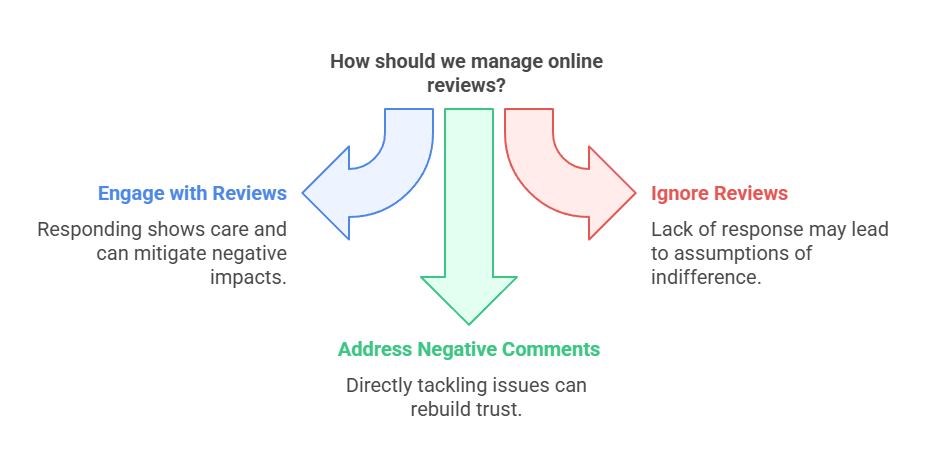How to Handle Negative Reviews as a Healthcare Provider
Managing patient care is challenging enough, but in today’s world, medical practice reputation management is just as important. Online reviews influence where people go for healthcare, and a few bad ones can make potential patients think twice. Whether the complaint is fair or not, how you handle it can make all the difference.
Ignoring negative reviews can damage trust, while responding poorly can make things worse. The good news? A thoughtful, professional approach can actually turn a bad review into a chance to show you care. This guide will walk you through the best ways to handle negative feedback, keep your practice’s reputation strong, and even turn unhappy patients into loyal ones.
1. Understanding the Impact of Negative Reviews
Online reviews can make or break a medical practice. A single bad review might not seem like a big deal, but if it’s handled poorly—or ignored—it can turn into a real problem. People check reviews before choosing a doctor, and if they see unanswered complaints, they might take their business elsewhere.

Here’s why negative reviews matter:
- Patients trust online reviews. Many people treat them like personal recommendations.
- Bad reviews can drive potential patients away. Even a few negative comments can raise red flags.
- A lack of responses can make things worse. If you don’t reply, people assume you don’t care.
The good news? Negative reviews don’t have to hurt your reputation. If you handle them well, you can actually turn them into a chance to build trust and show that patient satisfaction matters to your practice.
2. Responding Promptly and Professionally
The way you respond to a bad review says a lot about your practice. A thoughtful, professional reply can actually leave a better impression than a glowing review.
How to craft a good response:

Acknowledge the feedback. Thank the reviewer for sharing their thoughts, even if the review isn’t fair.
Keep it short and polite. Long, defensive responses don’t help. Stick to a sentence or two.
Avoid getting emotional. Stay calm, no matter how unfair the review might be.
Don’t argue online. If the situation needs further discussion, take it offline.
Follow HIPAA guidelines. Never confirm that someone is a patient or discuss private health details.
Example response:
“Thank you for your feedback. We strive to provide excellent care, and we’d love the opportunity to discuss your experience. Please call our office so we can address your concerns.”
A well-worded response shows that you care about patient experience while keeping things professional.
3. Ensuring HIPAA Compliance in Responses
Responding to reviews as a healthcare provider is tricky because you have to follow strict privacy laws. The Health Insurance Portability and Accountability Act (HIPAA) puts clear limits on what you can say, even if a patient brings up personal medical details in their review.
What You CANNOT Do in a Review Response:
- Confirm that the reviewer is a patient. Even if they say they visited your office, you can’t acknowledge it.
- Discuss any details of their visit. No mentioning treatments, diagnoses, or even appointment dates.
- Give medical advice. Keep responses general—don’t address health concerns publicly.
What You CAN Say:
- Keep it broad. Focus on practice policies, not individual cases.
- Encourage private communication. Offer a phone number or email so they can reach out.
- Express willingness to help. Show concern without violating privacy laws.
Example HIPAA-Compliant Response:
“We take patient concerns seriously and aim to provide the best care possible. Due to privacy laws, we can’t discuss specific cases online, but we’d love to talk with you directly. Please contact our office at [phone number] so we can address your concerns.”
Even if a reviewer shares personal health details, resist the urge to clarify or correct anything. Staying compliant is more important than defending your practice in public.
4. Taking Conversations Offline
Some issues can’t be resolved in a public comment section, and that’s okay. In fact, it’s often better to move things offline as quickly as possible.
Why Taking It Offline Works:

- It prevents online back-and-forth. A drawn-out public debate won’t help your reputation.
- You can gather more details. A phone call or in-person conversation allows for a clearer discussion.
- Patients feel heard. A direct conversation shows you actually care about fixing the problem.
How to Encourage a Private Discussion:
Acknowledge the complaint briefly in your response.
Provide a contact method (phone or email) for follow-up.
Invite them to call or visit to discuss further.
Example Response:
“We’re sorry to hear about your experience. We’d love the opportunity to discuss this further—please call us at [phone number] so we can make it right.”
Many times, simply offering to talk one-on-one will help defuse a situation before it escalates.
5. Implementing Staff Training and Response Protocols
Handling online reviews shouldn’t be left to guesswork. Every healthcare practice should have a clear plan for responding to feedback, especially negative reviews. This ensures consistency, professionalism, and compliance with medical practice reputation management standards.
Why Staff Training Matters
- Protects your practice from legal risks. Untrained staff might accidentally disclose private information.
- Ensures a professional, unified response. Every reply should reflect your practice’s values.
- Reduces stress when bad reviews come in. If staff know what to do, they won’t panic or react emotionally.
How to Train Your Team for Review Management
Create Pre-Approved Response Templates – Develop HIPAA-compliant templates for different situations. These can be slightly customized as needed.
Hold Regular Training Sessions – Make sure staff understand review policies, HIPAA rules, and the importance of keeping responses neutral and professional.
Designate a Response Team – Choose a few trusted staff members to handle online reviews instead of letting anyone reply.
Use a Review Monitoring System – Set up Google Alerts or reputation management software to keep track of feedback as it comes in.
Example Review Response Template:
“We appreciate feedback from all our patients. Our goal is to provide excellent care, and we’d love to speak with you directly to understand your concerns. Please call us at [phone number] to discuss.”
Having a system in place makes it easier to stay on top of negative reviews without making rushed decisions.
6. Learning and Adapting from Feedback
Negative reviews can feel frustrating, but they often highlight real areas where a practice can improve. Instead of just seeing them as complaints, think of them as patient feedback.
How to Use Negative Reviews for Growth
Look for common complaints. If multiple patients mention long wait times or rude staff, those issues need to be addressed.
Hold team discussions. Share feedback with your staff and brainstorm ways to improve.
Make small changes that lead to big results. Even small tweaks—like better front-desk training or clearer billing explanations—can make a difference.
Tracking Feedback for Long-Term Improvement
- Create a feedback log. Keep track of complaints and look for patterns.
- Survey patients directly. Don’t wait for online complaints—ask patients how their visit went.
- Celebrate improvements. If you fix an issue, let your patients know! Post about it on your website or social media.
Turning criticism into action is one of the best ways to strengthen medical practice reputation management.
7. Encouraging Positive Reviews
A few negative reviews won’t ruin your medical practice’s reputation—unless they’re the only ones patients see. The best way to balance out occasional complaints is to make sure happy patients are sharing their experiences too.

How to Get More Positive Reviews
Ask Satisfied Patients Directly – A simple, polite request can go a long way. Train your staff to ask patients at checkout if they’d be willing to leave a review.
Make It Easy – Provide a QR code or a direct link to your Google or Healthgrades page so patients don’t have to search for it.
Use Follow-Up Emails – After an appointment, send a thank-you email with a link to leave a review.
Highlight Positive Experiences on Social Media – Share patient testimonials (with permission) to encourage others to do the same.
Put Up Signage in Your Office – A small sign at the front desk that says, “Loved your visit? Leave us a review!” can be effective.
What NOT to Do
- Don’t buy fake reviews. It’s unethical and can get your practice penalized.
- Don’t pressure patients. Let them decide if they want to share their experience.
- Don’t ask for only positive reviews. Encourage honest feedback to build trust.
The more real, positive reviews you collect, the less impact one or two bad ones will have.
8. Monitoring and Managing Your Online Presence
If you’re not keeping an eye on your online reputation, you’re giving up control over how patients see your practice. Reputation management isn’t just about responding to reviews—it’s about actively monitoring what’s being said about your business.
How to Keep Track of Online Reviews
Set Up Google Alerts – Get notified when your practice is mentioned online.
Check Review Sites Weekly – Google, Yelp, Healthgrades, and RateMDs are key platforms for patient feedback.
Use Reputation Management Software – Tools like Podium, BirdEye, or Reputation.com can automate review tracking.
Respond to ALL Reviews (Not Just the Bad Ones) – Thank patients for positive reviews, too!
How to Handle Fake or Unfair Reviews
- Flag reviews that violate platform guidelines. If a review is completely false, report it to the site.
- Respond calmly and professionally. Even if you know a review is fake, reply as you would to a real complaint.
- Ask satisfied patients to leave more reviews. A steady flow of good feedback helps drown out false or unfair comments.
Taking an active role in your medical practice reputation management makes a huge difference in how new patients perceive your practice.
9. Highlighting Success Stories and Community Engagement
One of the best ways to counterbalance negative reviews is to make sure your online presence is filled with positive stories.
Ways to Showcase Your Practice in a Positive Light
Feature Patient Success Stories – With patient consent, share recovery stories or positive experiences.
Highlight Your Team’s Achievements – Celebrate milestones, certifications, and staff accomplishments.
Show Your Community Involvement – Share photos from health fairs, charity events, or local sponsorships.
Create Educational Content – Blog posts, videos, and social media tips can position your practice as a trusted resource.
When your online presence is filled with helpful, engaging content, one or two bad reviews won’t stand out nearly as much.
10. Knowing When to Seek Legal Counsel
In most cases, responding professionally is the best way to handle negative reviews. But there are situations where legal action might be necessary when addressing Medical Practice Reputation Management.
When to Consider Legal Help
A review is defamatory. False claims that damage your reputation may qualify as defamation.
Someone is harassing your practice. If an individual is posting multiple false reviews or spreading misinformation, you may need legal guidance.
Private health information is leaked. If a patient shares sensitive details and you need guidance on HIPAA-compliant responses.
How to Proceed
- Consult a lawyer before taking action. Don’t threaten legal action in a review response.
- Request removal through proper channels. Many review platforms allow for dispute resolution.
- Continue managing your reputation proactively. Legal steps should be a last resort.
Most negative reviews won’t require legal action, but knowing your rights is part of protecting your medical practice’s reputation.
Final Thoughts
Negative reviews aren’t the end of the world for a healthcare provider. When handled correctly, they’re actually opportunities to show professionalism, improve patient experience, and strengthen your medical practice reputation management.
Key Takeaways:
Respond quickly, politely, and professionally.
Follow HIPAA guidelines and keep patient details private.
Take conversations offline when possible.
Train staff on proper response protocols.
Use feedback to make real improvements.
Encourage happy patients to leave reviews.
Monitor and manage your online reputation actively.
Highlight positive patient experiences and community involvement.
Seek legal advice only when absolutely necessary.
By staying proactive, your practice can turn occasional negative feedback into an opportunity to build trust and improve the patient experience.
FAQ: Handling Negative Reviews as a Healthcare Provider
1. Can I delete negative reviews about my medical practice?
No, most review platforms don’t allow businesses to remove reviews, even if they’re negative. However, if a review is fake, defamatory, or violates platform guidelines, you can report it for removal. The best approach is to respond professionally and encourage satisfied patients to leave positive reviews.
2. How should I respond to a negative review without violating HIPAA?
Never confirm that someone is a patient or discuss their health details. Keep responses general, express a willingness to help, and direct the reviewer to contact your office privately. A simple, HIPAA-compliant response might be: “We take patient concerns seriously. Please call our office so we can address your concerns directly.”
3. How can I encourage more positive reviews for my practice?
Ask satisfied patients to leave a review, but don’t pressure them. Make it easy by providing a direct link or QR code. Follow up after visits with a polite request in an email or text. Highlighting positive reviews on your website and social media can also encourage others to share their experiences.
4. What should I do if a review is completely false?
If a review contains false information, report it to the platform for review. If it’s not removed, respond calmly and professionally to show that your practice takes feedback seriously. A response like, “We have no record of this experience. Please contact us so we can better understand your concerns,” helps manage the situation without escalating it.
5. How often should I check my practice’s online reviews?
At least once a week. Set up Google Alerts or use reputation management tools to get notified of new reviews. Responding quickly—especially to negative reviews—shows that you care about patient experience and are actively managing your medical practice’s reputation.




1 Comment
A Guide For Social Media Compliance and Privacy in Healthcare - Sociable Practices
3 weeks ago[…] Lead to bad press and negative media coverageCause patients to lose trust and switch providersHurt online reviews and social media reputation […]
Comments are closed.